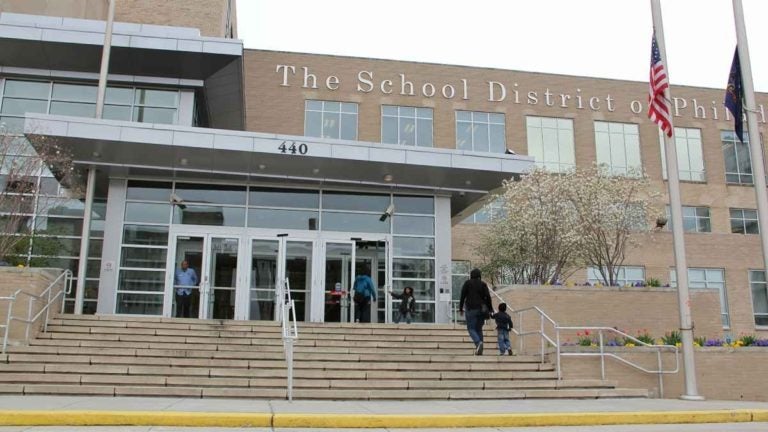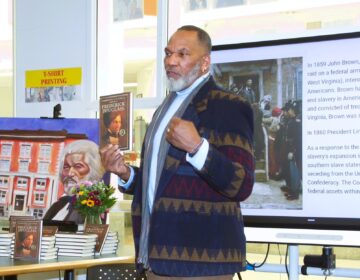Big week ahead for participation in comprehensive planning
But public meetings will not include open forums to question District officials

School District of Philadelphia. (Emma Lee/WHYY)
This article originally appeared on The Notebook.
–
The coming week will bring the public its first chance to participate in the Philadelphia School District’s new strategic planning process, but anyone hoping for a chance to air broad concerns or put questions directly to senior officials will likely be disappointed.
Officials say the District’s “Community Input Forums” will not operate like traditional town halls. Instead, the events officials describe will be more like carefully-managed small-group surveys. Rather than open the floor to general discussion, officials say their priority will be to gather responses to specific plans already being developed through the District’s Comprehensive School Planning Review (CSPR) process.
“The format will be tailored to maximize the ability of the CSPR team to collect feedback from parents and community members,” said District spokesperson Monica Lewis in a statement.
The goal of the CSPR process, launched this year, is to reorganize groups of neighborhood schools into more efficient K-12 networks. Options include closing or expanding schools, changing grade configurations, and redrawing catchment boundaries.
The District has been hosting invite-only CSPR meetings in three communities since November, at which delegations of school staff and select community members – known as “Study Area Committees” – have helped District officials develop plans for their communities.
This week’s forums – one each in the South, North and West Philadelphia study areas – will be the first of two opportunities for the public to directly participate in the CSPR process. A second set of three forums will take place in April, after which the CSPR team is expected to submit draft proposals to the Board of Education.
The forums will begin with a brief introduction to the process and its goals, after which attendees will split up by school community, to discuss the options developed by the CSPR team and the Study Area committees over the last three months.
“Once the [full group] welcome is complete, we will guide attendees to breakout rooms by school, where they will be provided with more detailed information about the data, issues, and proposed solutions that relate directly to their school,” said Lewis.
Lewis said that the doors will be open to all members of the public and press, “as long as it is not disruptive.” Attendees who aren’t tied to any particular school community will be welcome to join any one of the groups. Attendees will have time to check in with the other working groups at the end of the evening, she said, as well as ask questions of CSPR staff.
Senior District leaders such as Superintendent William Hite will not be on hand to discuss broad goals or hear general concerns. But Lewis said that one goal for the evening is to “gather input from the general public” about the process and the proposals generated “thus far.”
Plans take shape as officials stay quiet
District officials, who have promised a “transparent” and “inclusive” CSPR process, have released summaries of the Study Area Committee meetings, which show clearly how the various options are taking shape.
In South Philadelphia, major changes are being considered for the entire Study Area, including grade reconfigurations at some of the District’s most coveted schools. In North Philadelphia, all but one proposed plan would close Sheppard Elementary and scatter its students elsewhere, while in West Philadelphia, a number of possible changes are being considered, among them one that would close Overbrook Elementary School.
But beyond sharing the meeting summaries – usually posted without fanfare on the District’s CSPR website within few weeks of each meeting – officials have been very quiet about the process so far.
The CSPR team made its last public presentation at a Board committee meeting in December. Two weeks ago, Hite and a Queen Village community group cancelled what would have been the public’s first opportunity to directly question him about CSPR. And at Thursday’s school board meeting, while Hite promoted several upcoming events – including “Read Across America Day” on March 2 – no mention was made of the CSPR sessions.
But public interest in CSPR is growing. The Sheppard community is already organizing to build support for its school, which has been threatened with closure before. The community group Parents United for Public Education is planning a CSPR session of its own for March 7. At South Philadelphia’s Meredith Elementary – where one real estate dealer predicted “the mother of all battles” if catchment lines are redrawn – parents and staff are beginning to meet to discuss how CSPR will affect them.
And while District officials stress that no final decisions have been made, the window for making them is closing. After the March public forums, the closed-door Study Area committees will meet twice more before a second round of public meetings in April.
By May, the committees and the CSPR team are expected to have final proposals ready for consideration by the Board of Education. And while it is unclear what exactly these final proposals will include, what is clear is that the decisions made in the next eight to twelve weeks could affect the three study areas for generations to come.
South Philadelphia: out with K-8s, in with middle schools
Based on the CSPR meeting summaries, major changes appear to be afoot for South Philadelphia’s schools, which include some of the District’s most coveted destinations.
The District’s main goal for Study Area One is to move students from crowded, popular schools on the relatively prosperous east side of Broad Street, to less-used schools on the less-gentrified west side. District officials expect that in the coming years, demand will slow on the east side, and grow on the west.
The latest options for Study Area One include redrawing catchments to move students west, converting most K-8s into K-5s, and establishing one or two middle schools, potentially adding one on each side of Broad Street.
The only option listed that does not involve major reconfigurations is one reading simply, “Make more space in existing buildings.”
Aside from that, all of the other five options listed would eliminate the middle schools at Meredith, Nebinger, Childs, Vare-Washington, Arthur, Kirkbride, Stanton and McDaniel. One option would leave two schools – Southwark and Jackson – as K-8s. Most other options would reconfigure them as well.
The latest meeting summary notes that the “anecdotal feedback” from attendees included: “Good discussion among our group but not feeling it’s going to get relayed to CSPR,” and, “very limited options … options do not address issues.”
North Philadelphia: Sheppard back in the crosshairs
The general issue in Study Area Two is that all buildings are operating under capacity. Of the five options currently being considered, four would effectively close (“repurpose”) Sheppard Elementary, and send its students elsewhere in the area.
Also being considered are options that would reconfigure various elementary schools to make their grade configurations align with each other; options include changing Cramp from a K-5 to a K-4, or changing Elkin and Willard from K-4 to K-5s.
The District expects little or no growth in demand in this area, but is uncertain as to whether or not the migration to charter schools will continue. The impact of the area’s declining school-age population will be reduced “if the increasing rate of charter choice over time stabilizes,” the summary notes.
Anecdotal feedback included: “more talk than action,” “options presented today did not reflect previously offered feedback,” and “I really felt like I was being heard.”
West Philadelphia: options include closing Overbrook Elementary
Like Study Area Two, the basic profile of this slow-growing part of the city is that District schools have emptied out as students have migrated to charters and private schools. The reliance on both alternatives is “significantly higher in SA3 than in the District as a whole,” the summary notes.
Initial options for this area included closing Overbrook Elementary, transforming the remaining K-8s to K-5s, and opening a new middle school. The latest option would reconfigure Overbrook from a K-8 to a K-5, transform Cassidy from a K-8 to a middle school, and adjust curricula at Lamberton and Gompers to make them more appealing.
Anecdotal feedback included: “Closing Overbrook ES is not an option” and “Be more clear about scenario for Gompers.”
WHYY is your source for fact-based, in-depth journalism and information. As a nonprofit organization, we rely on financial support from readers like you. Please give today.




